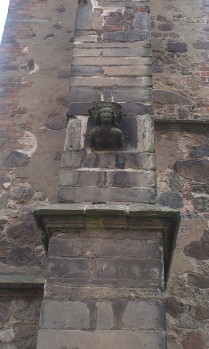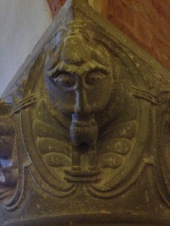Heathen Symbols in Zerbst
The town of Zerbst in Sachsen-Anhalt, Germany, was a very important town during the 14th and 15th century. As one of the oldest towns, the city had a couple of very old churches and other noteworthy buildings. Unfortunately most of the city was destroyed by inhuman, anglo-american attacks during the second world-war. Only a few ruins remained after this act of cultural vandalism. Some heathen symbols on the walls of church remained but are doomed to disappear forever in a couple of years. The Nicolai-church, of which only the walls remain, has a lot of interesting symbols and figures on it. Note that Nicolai is related to the cult of Odin/Wodan [Hnikar]. One particular well-preserved sculpture on the Nicolai-church is the so-called Judensau.
All pictures by J. De Cooman. You can reuse the pictures freely. Drop me a small note when you publish them.
Heathen Symbols in Breda
The city of Breda, Noord-Brabant, Netherlands, has a very rich history. During a visit I couldn’t resist to hunt for symbols in one of the oldest churches there. The Onze-Lieve-Vrouwekerk was built around 1410, probably on a (heathen) sacred site dedicated to the “Allmutter”. Although the church doesn’t have too much symbols, I found some surprises.
All pictures by J. De Cooman. You can reuse the pictures freely. Drop me a small note when you publish them.
Symbols in Monastery Jerichow
The Monastery in Jerichow (Sachsen-Anhalt, Germany) was built around the 12th century in the vicinity of the Elbe river. The monastery is one of the oldest Romanesque brick style buildings in the area. Once there was a castle there too, but it was destroyed. The building inside has been stripped of almost all symbols, but in the cellar some old symbols survived. The predominant symbol is the tree of life.
I can’t truly say in which period the artifacts with the symbols were made, but the ones in the cellar surely look like they have been there since the very beginning. Some of them have been partly destroyed. Maybe because of the heathen background, maybe it was religious or political vandalism during the different wars around the 16th century. It’s nearly impossible to say. Nevertheless, these symbols find their origin in the heathen world of our ancestors.
All pictures by J. De Cooman. You can reuse the pictures freely. Drop me a small note when you publish them.



















